JAXA Astronaut Activity Report, February, 2016
Last Updated: April 4, 2016
This is JAXA’s Japanese astronaut activity report for February, 2016.
Astronaut Kimiya Yui holds a press conference after returning to Japan
After attending the debriefing session and welcome home ceremonies in the U.S. and Russia, Astronaut Kimiya Yui returned to Japan for the first time since completing his mission as a member of the ISS Expedition 44/45 crew.
Following the opening remarks by Takashi Hamazaki, Director General of the JAXA Human Spaceflight Technology Directorate, Yui reported his experiences and activities on the ISS using the mission highlight video.
During the Q&A session, Yui discussed the taste of lettuce cultivated on the ISS, the view of Earth from the Soyuz decent module, plasma seen during reentry, condition of his rehabilitation after returning home, and his successful capture of the H-II Transfer Vehicle KOUNOTORI5 (HTV5). He also acknowledged Japan’s high technology and was delighted to have received fresh fruit delivered by KOUNOTORI5.
When viewing Earth from space, he felt keenly aware that we must protect both our environment and life on Earth, for which science technology and space development should be promoted through international cooperation.
When asked about his next goal, he simply replied: “The farther the destination, the better.” Before achieving such goal, he intends to do his best with the task at hand, and his present goal is to support Onishi’s mission.
Long-duration ISS mission training of Astronaut Takuya Onishi
Astronaut Takuya Onishi, a crew member for the ISS Expedition 48/49 mission, underwent training in February, mainly at the Gagarin Cosmonaut Training Center (GCTC) in Russia.
At the GCTC, Onishi practiced emergency responses in several cases of simulated fire accidents in the Russian segment.In responding to a fire alarm, Onishi and fellow crewmates rehearsed a series of operations where they first identified the origin of the fire, extinguished the fire, restored the automated safety response (such as power supply and shutdown air circulation), and finally performed post-fire atmospheric recovery.
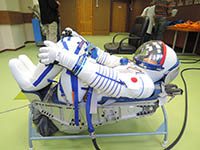
Wearing the pressurized Sokol spacesuit, a fit-check is made with the custom-made seat liner (Photo courtesy of Takuya Onishi)
The training included other scenarios such as responding to a smoke detector generating a false alarm, a case that would otherwise require evacuation from the ISS with the Soyuz spacecraft if the crew were unable to extinguish the fire.
On another day, Onishi visited Zvezda, the manufacturer of Sokol spacesuits, for a fitting of his Sokol spacesuit to be worn during flight and a custom-made seat liner for the Soyuz spacecraft.
The seat liner for the Soyuz spacecraft is custom-made to properly fit the body of each cosmonaut or astronaut. To alleviate the impact of touchdown, Onishi’s center of body while seated was measured, and the spacesuit was pressurized at 0.4 atm* to determine whether there are any painful or uncomfortable parts.
*Even if air pressure in the spacecraft drops to zero, 0.4 atm oxygen is maintained inside the Sokol spacesuits.
The fit-check was made with an inflated Sokol spacesuit where internal pressure was increased by 0.4 atm (and thereby tested with absolute pressure of 1.4 atm).
Astronaut Norishige Kanai undergoes winter survival training in Russia
In early February, Astronaut Norishige Kanai, assigned as a crew member for the Expedition 54/55 mission, underwent outdoor winter survival training in Russia.
This training is intended to teach participants survival skills in the event that the Soyuz spacecraft is forced to make an emergency landing.
Kanai experienced life outdoors in sub-zero temperatures along with two other participants; one from NASA and one from Roscosmos. The training lasted two nights and three days, because it may take two or three days to conduct search and rescue operations in case the Soyuz spacecraft is forced to touch down at an unpredictable and remote location.
Simulating that they had just landed on the ground, they began by removing their Sokol spacesuits and changing into snowsuits aboard the Soyuz spacecraft. Then they selected a camping location and set up a shelter by using the spacecraft’s parachute and hewn wood they had collected.The trio made a fire with the wood they collected, and then took turns tending the fire at night.
The training included a case of simulated injury to one crew member. They practiced how to treat the injured part, such as applying a splint and covering the injured crewmate with a rescue sheet.
And in following the specified procedure, they also ignited flares to draw the attention of any rescue team.
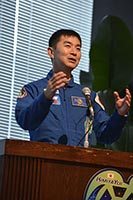
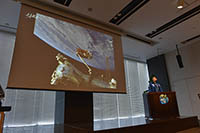
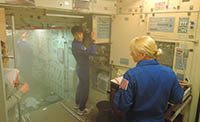
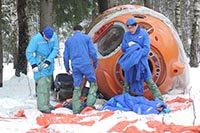
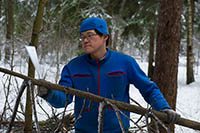
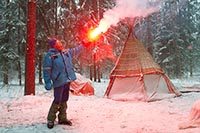
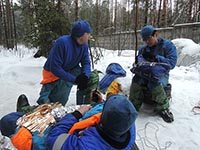
Comments are closed.